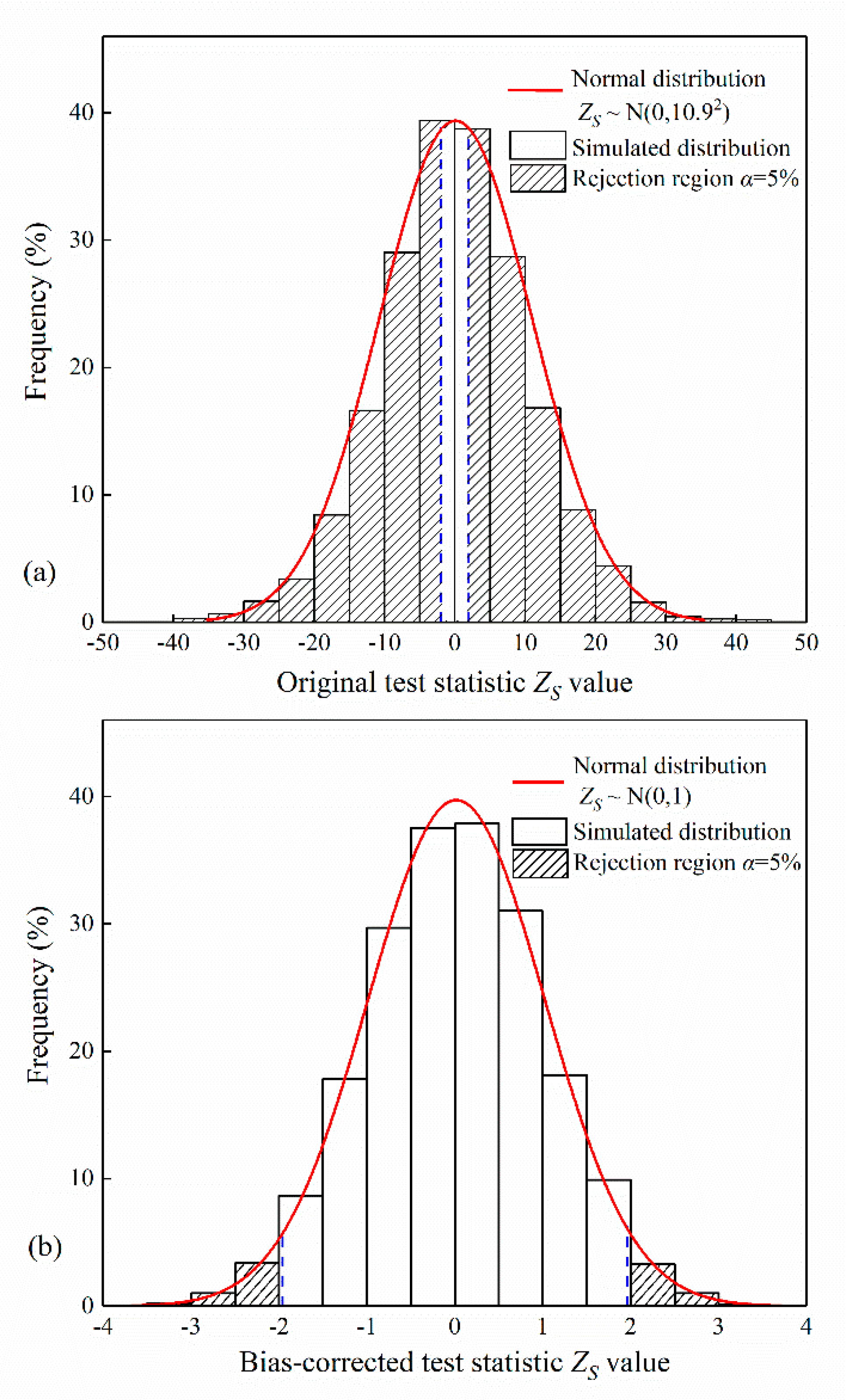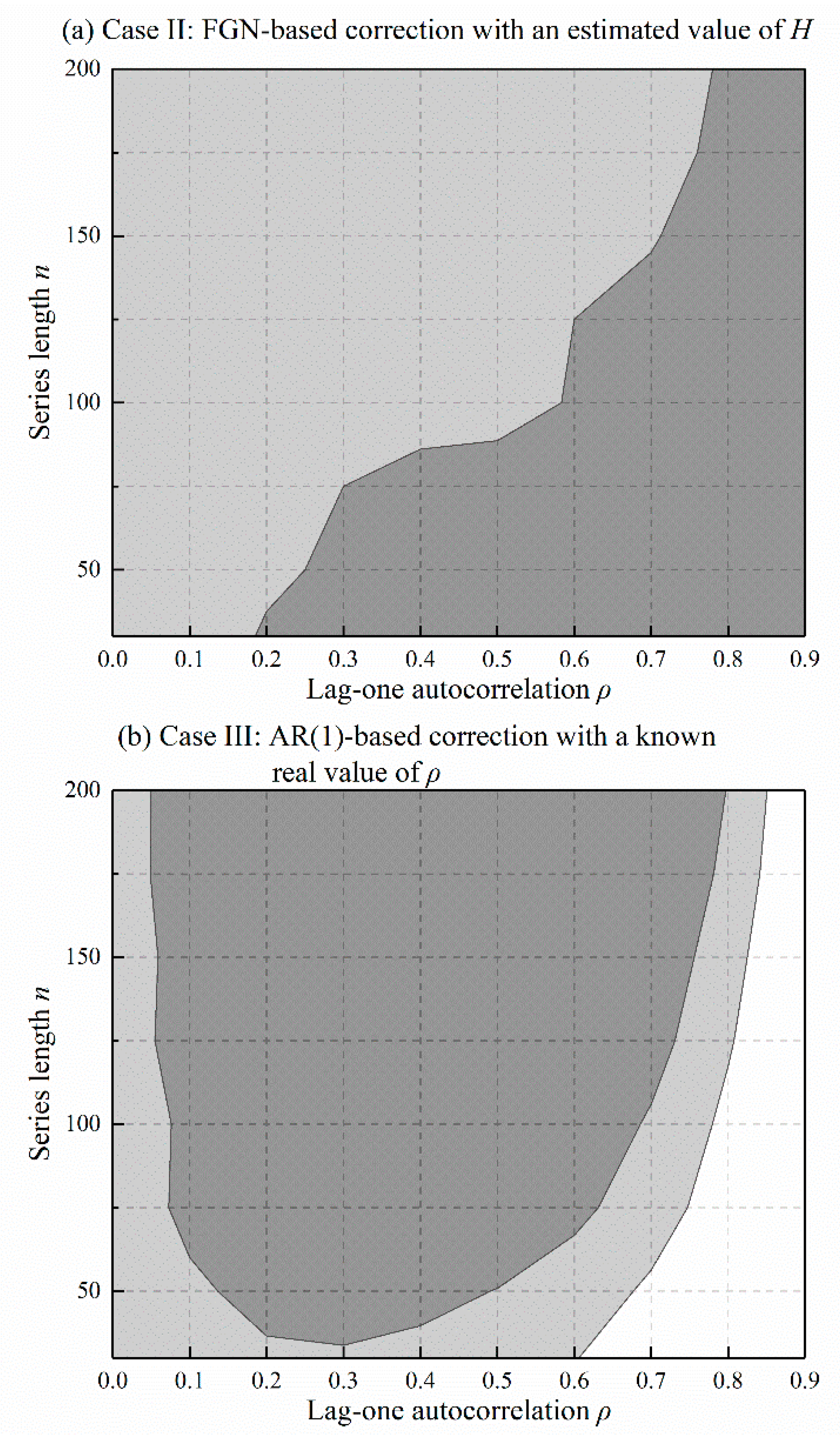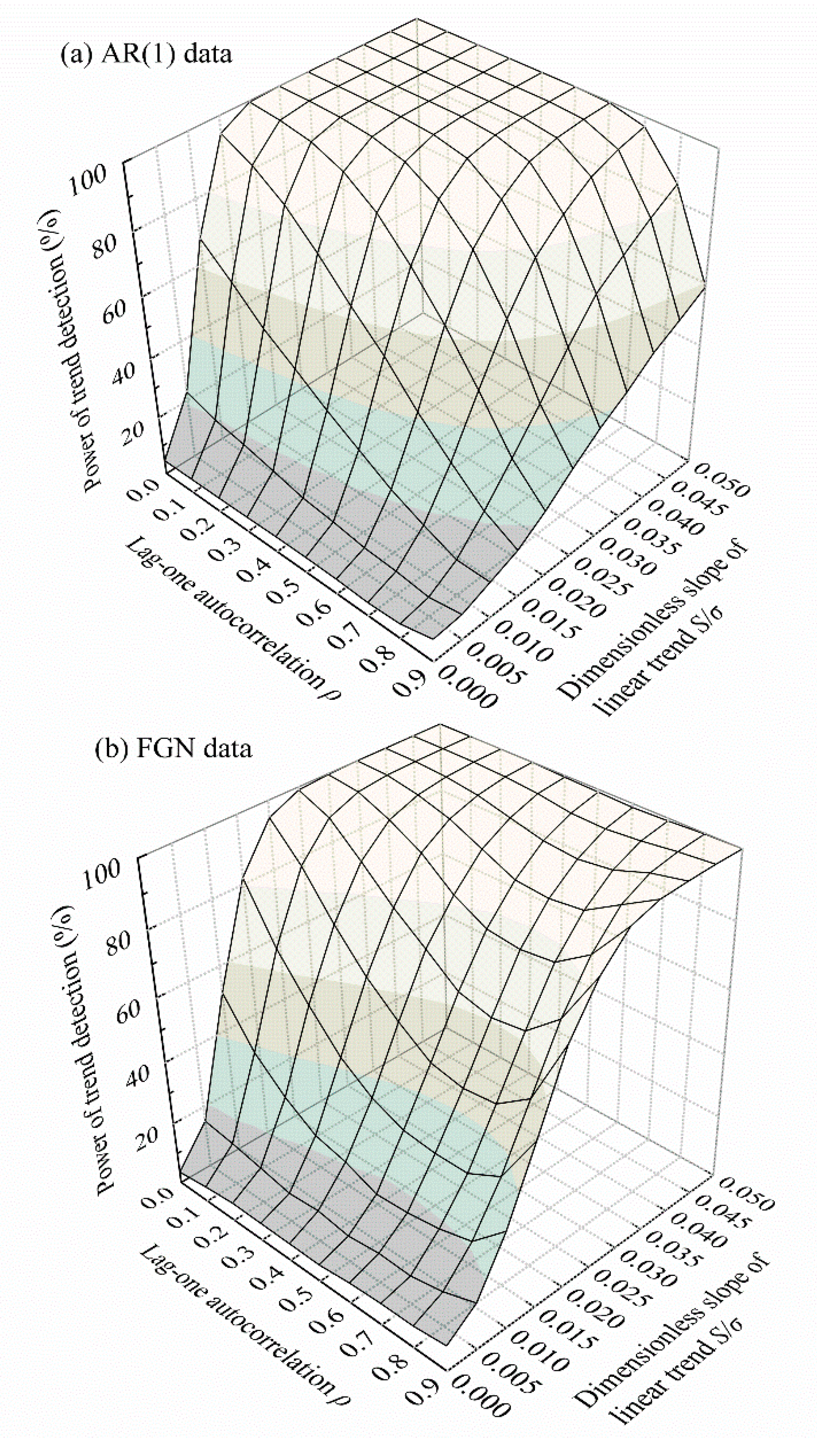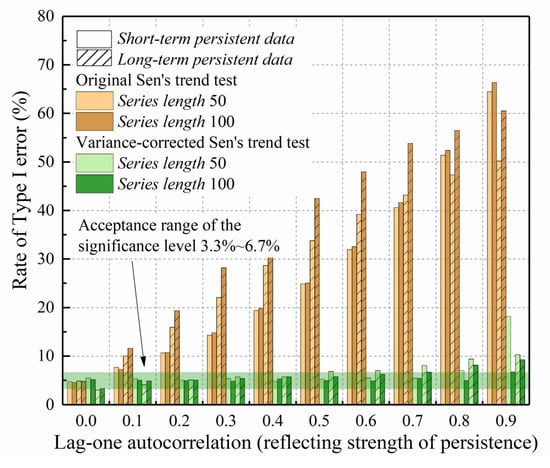Innovative Variance Corrected Sen’s Trend Test on Persistent Hydrometeorological Data
Abstract
:1. Introduction
2. Sen’s Trend Detection Method
2.1. Sen’s Trend Plot
2.2. Sen’s Trend Test
3. The Influence of Persistence on the Original Sen’s Trend Test
3.1. Persistence in Hydrometeorological Data
3.2. Inflation of Trend Slope Variance and Type I Error
4. Variance Corrected Sen’s Trend Test
4.1. Theoretical Basis for Correcting Slope Variance
4.2. Practical Procedure of the Method
- Step 1:
- Persistent model specification. The empirical lag-one autocorrelation coefficients of the aggregated time series are plotted versus the time scales. If the lag-one autocorrelations are almost constant or decay slowly for large time scales, the time series is regarded as a representation of an FGN process. Otherwise, the lag-one autocorrelations will drop down to zero after a few time scales; in this case, the time series is classified as an AR(1) process.
- Step 2:
- Persistent parameter estimation. For the AR(1) data, the empirical lag-one autocorrelation coefficient is estimated from the detrended series, and subsequently bias-corrected as recommended by Hamed [39]: . For the FGN data, the Hurst coefficient is estimated via the maximum likelihood method, which has been proven to be robust and to present low bias, as compared to several other methods [40].
- Step 3:
- Slope variance correction. The corrected slope variance is calculated using Equation (15) for AR(1) data or Equation (16) for FGN data, according to the results of the persistent model specification.
- Step 4:
- Trend significance assessment. The variance-corrected test statistic is compared with the quantiles of the standard Normal distribution at a desired significance level, and the trend significance is quantified.
5. Monte-Carlo Simulation
5.1. Simulation Design
5.2. Slope Variance Correction and its Effectiveness on Mitigating Type I Error Inflation
5.3. Power of Trend Detection
6. Application to Real-World Data
7. Conclusions
Author Contributions
Funding
Acknowledgments
Conflicts of Interest
References
- IPCC. Summary for Policymakers. In Global Warming of 1.5 °C; An IPCC special report on the impacts of global warming of 1.5 °C above pre-industrial levels and related global greenhouse gas emission pathways, in the context of strengthening the global response to the threat of climate change, sustainable development, and efforts to eradicate poverty; 2018; in press. [Google Scholar]
- Jimenez Cisneros, B.E.; Oki, T.; Arnell, N.W.; Benito, G.; Cogley, J.G.; Doll, P.; Jiang, T.; Mwakalila, S.S. Freshwater Resources. In Climate Change 2014: Impacts, Adaptation, and Vulnerability. Part A: Global and Sectoral Aspects; Contribution of working group II to the Fifth Assessment Report of the Intergovernmental Panel on Climate Change; Cambridge University Press: Cambridge, UK; New York, NY, USA, 2014. [Google Scholar]
- Durocher, M.; Requena, A.I.; Burn, D.H.; Pellerin, J. Analysis of trends in annual streamflow to the Arctic Ocean. Hydrol. Process. 2019, 33, 1143–1151. [Google Scholar] [CrossRef]
- Arora, R.; Tockner, K.; Venohr, M. Changing river temperatures in northern Germany: Trends and drivers of change. Hydrol. Process. 2016, 30, 3084–3096. [Google Scholar] [CrossRef]
- Gao, T.; Wang, H. Trends in precipitation extremes over the Yellow River basin in north China: Changing properties and causes. Hydrol. Process. 2017, 31, 2412–2428. [Google Scholar] [CrossRef]
- Hodgkins, G.A.; Dudley, R.W.; Archfield, S.A.; Renard, B. Effects of climate, regulation, and urbanization on historical flood trends in the United States. J. Hydrol. 2019, 573, 697–709. [Google Scholar] [CrossRef]
- Yeste, P.; Dorador, J.; Martin-Rosales, W.; Molero, E.; Esteban-Parra, M.J.; Rueda, F.J. Climate-driven trends in the streamflow records of a reference hydrologic network in southern Spain. J. Hydrol. 2018, 566, 55–72. [Google Scholar] [CrossRef]
- Garbrecht, J.; Fernandez, G.P. Visualization of trends and fluctuations in climatic records. Water Resour. Bull. 1994, 30, 297–306. [Google Scholar] [CrossRef]
- Basarin, B.; Lukic, T.; Pavic, D.; Wilby, R.L. Trends and multi-annual variability of water temperatures in the river Danube, Serbia. Hydrol. Process. 2016, 30, 3315–3329. [Google Scholar] [CrossRef] [Green Version]
- Sen, Z. Innovative trend analysis methodology. J. Hydrol. Eng. 2012, 17, 1042–1046. [Google Scholar] [CrossRef]
- Sen, Z. Innovative trend significance test and applications. Theor. Appl. Climatol. 2017, 127, 939–947. [Google Scholar] [CrossRef]
- Sen, Z. Trend identification simulation and application. J. Hydrol. Eng. 2014, 19, 635–642. [Google Scholar] [CrossRef]
- Wu, H.; Qian, H. Innovative trend analysis of annual and seasonal rainfall and extreme values in Shaanxi, China, since the 1950s. Int. J. Climatol. 2017, 37, 2582–2592. [Google Scholar] [CrossRef]
- Caloiero, T.; Coscarelli, R.; Ferrari, E. Application of the innovative trend analysis method for the trend analysis of rainfall anomalies in southern Italy. Water Resour. Manag. 2018, 32, 4971–4983. [Google Scholar] [CrossRef]
- Dabanli, I.; Sen, Z.; Yelegen, M.O.; Sisman, E.; Selek, B.; Guclu, Y.S. Trend assessment by the innovative-Sen method. Water Resour. Manag. 2016, 30, 5193–5203. [Google Scholar] [CrossRef]
- Belihu, M.; Abate, B.; Tekleab, S.; Bewket, W. Hydro-meteorological trends in the Gidabo catchment of the Rift Valley Lakes basin of Ethiopia. Phys. Chem. Earth 2018, 104, 84–101. [Google Scholar] [CrossRef]
- Cui, L.F.; Wang, L.C.; Lai, Z.P.; Tian, Q.; Liu, W.; Li, J. Innovative trend analysis of annual and seasonal air temperature and rainfall in the Yangtze River basin, China during 1960–2015. J. Atmos. Sol. Terr. Phys. 2017, 164, 48–59. [Google Scholar] [CrossRef]
- Kisi, O. An innovative method for trend analysis of monthly pan evaporations. J. Hydrol. 2015, 527, 1123–1129. [Google Scholar] [CrossRef]
- Zhou, Z.G.; Wang, L.C.; Lin, A.W.; Zhang, M.; Niu, Z.G. Innovative trend analysis of solar radiation in China during 1962–2015. Renew. Energy 2018, 119, 675–689. [Google Scholar] [CrossRef]
- Kisi, O.; Ay, M. Comparison of Mann–Kendall and innovative trend method for water quality parameters of the Kizilirmak River, Turkey. J. Hydrol. 2014, 513, 362–375. [Google Scholar] [CrossRef]
- Deng, S.L.; Chen, T.; Yang, N.; Qu, L.; Li, M.C.; Chen, D. Spatial and temporal distribution of rainfall and drought characteristics across the Pearl River basin. Sci. Total Environ. 2018, 619, 28–41. [Google Scholar] [CrossRef]
- Tosunoglu, F.; Kisi, O. Trend analysis of maximum hydrologic drought variables using Mann–Kendall and Sen’s innovative trend method. River Res. Appl. 2017, 33, 597–610. [Google Scholar] [CrossRef]
- O’Connell, P.E.; Koutsoyiannis, D.; Lins, H.F.; Markonis, Y.; Montanari, A.; Cohn, T. The scientific legacy of Harold Edwin Hurst (1880–1978). Hydrol. Sci. J. 2016, 61, 1571–1590. [Google Scholar] [CrossRef]
- Sen, Z.K. Hydrological trend analysis with innovative and over-whitening procedures. Hydrol. Sci. J. 2017, 62, 294–305. [Google Scholar] [CrossRef]
- Burger, G. On trend detection. Hydrol. Process. 2017, 31, 4039–4042. [Google Scholar] [CrossRef]
- Hamed, K.H. Trend detection in hydrologic data: The Mann–Kendall trend test under the scaling hypothesis. J. Hydrol. 2008, 349, 350–363. [Google Scholar] [CrossRef]
- Wang, W.; Chen, Y.; Becker, S.; Liu, B. Linear trend detection in serially dependent hydrometeorological data based on a variance correction Spearman Rho method. Water 2015, 7, 7045–7065. [Google Scholar] [CrossRef]
- Koutsoyiannis, D. The Hurst phenomenon and Fractional Gaussian Noise made easy. Hydrol. Sci. J. 2002, 47, 573–595. [Google Scholar] [CrossRef]
- Hurst, H.E. Long-term storage capacity of reservoirs. Trans. Am. Soc. Civ. Eng. 1951, 116, 770–808. [Google Scholar]
- Mandelbrot, B.B.; Wallis, J.R. Some long-run properties of geophysical records. Water Resour. Res. 1969, 5, 321–340. [Google Scholar] [CrossRef] [Green Version]
- Koutsoyiannis, D. Climate change, the Hurst phenomenon, and hydrological statistics. Hydrol. Sci. J. 2003, 48, 3–24. [Google Scholar] [CrossRef]
- Koutsoyiannis, D. Nonstationarity versus scaling in hydrology. J. Hydrol. 2006, 324, 239–254. [Google Scholar] [CrossRef] [Green Version]
- Koutsoyiannis, D. Hydrology and change. Hydrol. Sci. J. 2013, 58, 1177–1197. [Google Scholar] [CrossRef]
- Matalas, N.C.; Sankarasubramanian, A. Effect of persistence on trend detection via regression. Water Resour. Res. 2003, 39, 1342. [Google Scholar] [CrossRef]
- Dimitriadis, P.; Koutsoyiannis, D. Stochastic synthesis approximating any process dependence and distribution. Stoch. Environ. Res. Risk Assess. 2018, 32, 1493–1515. [Google Scholar] [CrossRef]
- Tsoukalas, I.; Makropoulos, C.; Koutsoyiannis, D. Simulation of stochastic processes exhibiting any-range dependence and arbitrary marginal distributions. Water Resour. Res. 2018, 54, 9484–9513. [Google Scholar] [CrossRef]
- Iliopoulou, T.; Papalexiou, S.M.; Markonis, Y.; Koutsoyiannis, D. Revisiting long-range dependence in annual precipitation. J. Hydrol. 2018, 556, 891–900. [Google Scholar] [CrossRef]
- Markonis, Y.; Moustakis, Y.; Nasika, C.; Sychova, P.; Dimitriadis, P.; Hanel, M.; Maca, P.; Papalexiou, M. Global estimation of long-term persistence in annual river runoff. Adv. Water Resour. 2018, 113, 1–12. [Google Scholar] [CrossRef]
- Hamed, K.H. Enhancing the effectiveness of prewhitening in trend analysis of hydrologic data. J. Hydrol. 2009, 368, 143–155. [Google Scholar] [CrossRef]
- Tyralis, H.; Koutsoyiannis, D. Simultaneous estimation of the parameters of the Hurst-Kolmogorov stochastic process. Stoch. Environ. Res. Risk Assess. 2011, 25, 21–33. [Google Scholar] [CrossRef]
- Serinaldi, F.; Kilsby, C. The importance of prewhitening in change point analysis under persistence. Stoch. Environ. Res. Risk Assess. 2016, 30, 763–777. [Google Scholar] [CrossRef]
- Li, J.; Wu, W.; Ye, X.; Jiang, H.; Gan, R.; Wu, H.; He, J.; Jiang, Y. Innovative trend analysis of main agriculture natural hazards in China during 1989–2014. Nat. Hazards 2018, 95, 677–720. [Google Scholar] [CrossRef]
- Harris, I.; Jones, P.D.; Osborn, T.J.; Lister, D.H. Updated high-resolution grids of monthly climatic observations—The CRU TS3.10 dataset. Int. J. Climatol. 2014, 34, 623–642. [Google Scholar] [CrossRef]
- Cohn, T.A.; Lins, H.F. Nature’s style: Naturally trendy. Geophys. Res. Lett. 2005, 32, L23402. [Google Scholar] [CrossRef]
- Ludescher, J.; Bunde, A.; Franzke, C.L.E.; Schellnhuber, H.J. Long-term persistence enhances uncertainty about anthropogenic warming of Antarctica. Clim. Dyn. 2016, 46, 263–271. [Google Scholar] [CrossRef]










| n | ||||||||||
|---|---|---|---|---|---|---|---|---|---|---|
| 0 | 0.1 | 0.2 | 0.3 | 0.4 | 0.5 | 0.6 | 0.7 | 0.8 | 0.9 | |
| AR(1) data | ||||||||||
| 30 | 1.00 | 1.21 | 1.44 | 1.74 | 2.11 | 2.61 | 3.24 | 4.15 | 5.19 | 5.69 |
| 50 | 1.00 | 1.21 | 1.46 | 1.79 | 2.20 | 2.77 | 3.54 | 4.73 | 6.63 | 9.21 |
| 100 | 1.00 | 1.21 | 1.48 | 1.82 | 2.26 | 2.89 | 3.77 | 5.18 | 7.80 | 13.61 |
| 150 | 1.00 | 1.22 | 1.49 | 1.83 | 2.29 | 2.92 | 3.83 | 5.36 | 8.16 | 15.45 |
| 200 | 1.00 | 1.22 | 1.49 | 1.84 | 2.31 | 2.94 | 3.89 | 5.44 | 8.38 | 16.31 |
| FGN data | ||||||||||
| 30 | 1.00 | 1.31 | 1.64 | 1.95 | 2.24 | 2.43 | 2.52 | 2.39 | 1.99 | 1.23 |
| 50 | 1.00 | 1.41 | 1.87 | 2.36 | 2.85 | 3.28 | 3.55 | 3.53 | 3.07 | 1.97 |
| 100 | 1.00 | 1.54 | 2.24 | 3.06 | 4.02 | 4.91 | 5.69 | 6.03 | 5.55 | 3.74 |
| 150 | 1.00 | 1.63 | 2.51 | 3.57 | 4.90 | 6.25 | 7.47 | 8.21 | 7.77 | 5.45 |
| 200 | 1.00 | 1.70 | 2.71 | 3.98 | 5.62 | 7.37 | 9.09 | 10.20 | 9.93 | 7.09 |
| n | ||||||||||
|---|---|---|---|---|---|---|---|---|---|---|
| 0 | 0.1 | 0.2 | 0.3 | 0.4 | 0.5 | 0.6 | 0.7 | 0.8 | 0.9 | |
| Case I: AR(1)-based correction with a known real value of | ||||||||||
| 30 | 1.00 | 1.01 | 1.00 | 1.00 | 1.00 | 1.00 | 1.00 | 1.01 | 1.00 | 1.00 |
| 50 | 1.00 | 1.00 | 1.00 | 1.00 | 1.00 | 1.00 | 1.00 | 1.00 | 1.00 | 1.00 |
| 100 | 1.00 | 1.00 | 1.00 | 1.00 | 1.00 | 1.00 | 1.00 | 1.00 | 1.00 | 1.00 |
| 150 | 1.00 | 1.00 | 1.00 | 1.00 | 1.00 | 1.00 | 0.99 | 1.00 | 1.00 | 1.00 |
| 200 | 1.00 | 1.00 | 1.00 | 1.00 | 1.00 | 1.00 | 1.00 | 1.00 | 1.00 | 1.00 |
| Case II: AR(1)-based correction with an estimated value of | ||||||||||
| 30 | 0.91 | 0.91 | 0.89 | 0.88 | 0.89 | 0.90 | 0.97 | 1.22 | 1.76 | 2.89 |
| 50 | 0.95 | 0.94 | 0.92 | 0.92 | 0.90 | 0.90 | 0.91 | 0.95 | 1.15 | 2.17 |
| 100 | 0.97 | 0.96 | 0.96 | 0.96 | 0.95 | 0.95 | 0.93 | 0.91 | 0.89 | 1.19 |
| 150 | 0.99 | 0.98 | 0.98 | 0.97 | 0.97 | 0.96 | 0.95 | 0.94 | 0.91 | 0.97 |
| 200 | 0.99 | 0.99 | 0.99 | 0.98 | 0.98 | 0.96 | 0.97 | 0.96 | 0.93 | 0.91 |
| Case III: FGN-based correction with a known real value of Hurst coefficient | ||||||||||
| 30 | 1.00 | 0.92 | 0.88 | 0.89 | 0.95 | 1.07 | 1.29 | 1.74 | 2.61 | 4.63 |
| 50 | 1.00 | 0.86 | 0.78 | 0.76 | 0.77 | 0.84 | 1.00 | 1.34 | 2.16 | 4.67 |
| 100 | 1.00 | 0.79 | 0.66 | 0.59 | 0.56 | 0.59 | 0.66 | 0.86 | 1.41 | 3.64 |
| 150 | 1.00 | 0.75 | 0.60 | 0.51 | 0.47 | 0.47 | 0.51 | 0.66 | 1.05 | 2.84 |
| 200 | 1.00 | 0.72 | 0.55 | 0.46 | 0.41 | 0.40 | 0.43 | 0.53 | 0.84 | 2.29 |
| n | ||||||||||
|---|---|---|---|---|---|---|---|---|---|---|
| 0 | 0.1 | 0.2 | 0.3 | 0.4 | 0.5 | 0.6 | 0.7 | 0.8 | 0.9 | |
| Case I: FGN-based correction with a known real value of Hurst coefficient | ||||||||||
| 30 | 1.00 | 1.00 | 1.00 | 1.00 | 1.00 | 1.00 | 1.00 | 1.00 | 1.00 | 1.00 |
| 50 | 1.00 | 1.00 | 1.00 | 1.00 | 1.00 | 1.00 | 1.00 | 1.00 | 1.00 | 1.00 |
| 100 | 1.00 | 1.00 | 1.00 | 1.00 | 1.00 | 1.00 | 1.00 | 1.01 | 1.01 | 1.00 |
| 150 | 1.00 | 1.00 | 1.00 | 1.00 | 1.00 | 1.00 | 1.00 | 1.00 | 1.00 | 1.00 |
| 200 | 1.00 | 1.00 | 1.00 | 1.00 | 1.00 | 1.00 | 1.00 | 1.00 | 1.00 | 1.00 |
| Case II: FGN-based correction with an estimated value of | ||||||||||
| 30 | 0.91 | 1.08 | 1.24 | 1.32 | 1.41 | 1.49 | 1.55 | 1.67 | 1.75 | 1.89 |
| 50 | 0.90 | 1.08 | 1.16 | 1.24 | 1.26 | 1.32 | 1.37 | 1.47 | 1.56 | 1.67 |
| 100 | 0.89 | 1.06 | 1.11 | 1.13 | 1.15 | 1.15 | 1.21 | 1.29 | 1.37 | 1.47 |
| 150 | 0.89 | 1.05 | 1.09 | 1.10 | 1.11 | 1.13 | 1.16 | 1.20 | 1.26 | 1.38 |
| 200 | 0.89 | 1.05 | 1.07 | 1.08 | 1.08 | 1.10 | 1.12 | 1.16 | 1.21 | 1.30 |
| Case III: AR(1)-based correction with a known real value of | ||||||||||
| 30 | 1.00 | 1.09 | 1.14 | 1.12 | 1.06 | 0.94 | 0.77 | 0.58 | 0.38 | 0.22 |
| 50 | 1.00 | 1.17 | 1.28 | 1.33 | 1.29 | 1.19 | 1.00 | 0.74 | 0.46 | 0.21 |
| 100 | 1.00 | 1.27 | 1.51 | 1.68 | 1.77 | 1.71 | 1.51 | 1.16 | 0.71 | 0.27 |
| 150 | 1.00 | 1.34 | 1.68 | 1.95 | 2.14 | 2.15 | 1.94 | 1.53 | 0.95 | 0.35 |
| 200 | 1.00 | 1.39 | 1.81 | 2.17 | 2.44 | 2.51 | 2.34 | 1.87 | 1.18 | 0.44 |
| Variables | Statistical Features | Data Persistence | Slope Variance | Test Statistic 1 | ||||
|---|---|---|---|---|---|---|---|---|
| Mean | Model | Parameter | ||||||
| Rainy days | 103 days | 0.008 | AR(1) | 7.9 × 10−5 | 7.2 × 10−5 | 2.62 ++ | 2.74 ++ | |
| Annual total flow | 3.44 Gm3 | 0.005 | AR(1) | 2.1 × 10−6 | 4.5 × 10−6 | 3.22 ++ | 2.17 + | |
| Frost days | 166 days | −0.017 | FGN | (0.879)b | 0.2 × 10−3 | 0.2 × 10−2 (0.9 × 10−3) | −5.18 ++ | −1.85 (−2.55 +) |
© 2019 by the authors. Licensee MDPI, Basel, Switzerland. This article is an open access article distributed under the terms and conditions of the Creative Commons Attribution (CC BY) license (http://creativecommons.org/licenses/by/4.0/).
Share and Cite
Wang, W.; Zhu, Y.; Liu, B.; Chen, Y.; Zhao, X. Innovative Variance Corrected Sen’s Trend Test on Persistent Hydrometeorological Data. Water 2019, 11, 2119. https://doi.org/10.3390/w11102119
Wang W, Zhu Y, Liu B, Chen Y, Zhao X. Innovative Variance Corrected Sen’s Trend Test on Persistent Hydrometeorological Data. Water. 2019; 11(10):2119. https://doi.org/10.3390/w11102119
Chicago/Turabian StyleWang, Wenpeng, Yuelong Zhu, Bo Liu, Yuanfang Chen, and Xu Zhao. 2019. "Innovative Variance Corrected Sen’s Trend Test on Persistent Hydrometeorological Data" Water 11, no. 10: 2119. https://doi.org/10.3390/w11102119
APA StyleWang, W., Zhu, Y., Liu, B., Chen, Y., & Zhao, X. (2019). Innovative Variance Corrected Sen’s Trend Test on Persistent Hydrometeorological Data. Water, 11(10), 2119. https://doi.org/10.3390/w11102119







